A Year in Dance: 2014
By Lisa Traiger
 My year 2014 in dance opened in January with the return of the now annually visiting Mariinsky Ballet to the Kennedy Center Opera House. Though the company brought Swan Lake, the company’s signature work – created on this most famous classical troupe by Marius Petipa and Lev Ivanov in 1895 – was not what we saw. Instead the “Sovietized” Konstantin Sergeyev 1950 version, filled with pomp and additions startling for Western audiences (a second corps of black swans, for example, in the “white” act), was on offer. Ultimately, the true star was the singular corps de ballet. Who can resist the Mariinsky’s 32 perfectly synchronized white swans in act two? The impeccable Vaganova training remains one of the Mariinsky’s most essential hallmarks. Even standing still, the corps breathes together as one body; in stillness they’re dancing. The result is simply stunning and awe-inspiring, ballet at its best.
My year 2014 in dance opened in January with the return of the now annually visiting Mariinsky Ballet to the Kennedy Center Opera House. Though the company brought Swan Lake, the company’s signature work – created on this most famous classical troupe by Marius Petipa and Lev Ivanov in 1895 – was not what we saw. Instead the “Sovietized” Konstantin Sergeyev 1950 version, filled with pomp and additions startling for Western audiences (a second corps of black swans, for example, in the “white” act), was on offer. Ultimately, the true star was the singular corps de ballet. Who can resist the Mariinsky’s 32 perfectly synchronized white swans in act two? The impeccable Vaganova training remains one of the Mariinsky’s most essential hallmarks. Even standing still, the corps breathes together as one body; in stillness they’re dancing. The result is simply stunning and awe-inspiring, ballet at its best.
 Compagnie Kafig’s hip hop with a French accent and a circus flair rocked the Kennedy Center in February. Founded in 1996 by Mourad Merzouki in a suburb of Lyon, Kafig’s all-male troupe of athletic dancers flip and tumble, punching out percussive beats and floor work that toggle between their North African roots and b-boy street moves. Merzouki’s latest interest is capoeira, the Afro-Brazilian dance-cum-martial-art. His “Agwa” featured about 100 cups of water, arrayed in grids, poured and re-poured, along with plenty of circusy tricks and surprises. Hip hop dance has for a generation-plus moved beyond its inner-city, thug-life street demeanor; we see the results daily in popular culture, on television and in suburban dance studios. Kafig’s creative and expansive approach drawing from North African and Afro Brazilian rhythms and French circus opens up a whole new world for this home-grown vernacular form.
Compagnie Kafig’s hip hop with a French accent and a circus flair rocked the Kennedy Center in February. Founded in 1996 by Mourad Merzouki in a suburb of Lyon, Kafig’s all-male troupe of athletic dancers flip and tumble, punching out percussive beats and floor work that toggle between their North African roots and b-boy street moves. Merzouki’s latest interest is capoeira, the Afro-Brazilian dance-cum-martial-art. His “Agwa” featured about 100 cups of water, arrayed in grids, poured and re-poured, along with plenty of circusy tricks and surprises. Hip hop dance has for a generation-plus moved beyond its inner-city, thug-life street demeanor; we see the results daily in popular culture, on television and in suburban dance studios. Kafig’s creative and expansive approach drawing from North African and Afro Brazilian rhythms and French circus opens up a whole new world for this home-grown vernacular form.
In April, Rockville’s forward-thinking American Dance Institute presented the legendary post modernist Yvonne Rainer. Now 79 and still making new work, Rainer is credited in the 1960s with coining the term post-modern for dance and as part of the experimental Judson Church movement taking dance into new, uncharted realms. She famously penned her “No” manifesto – “No to spectacle. No to virtuosity. No to transformations and magic and make-believe. No to the glamour and transcendency of the star image” – which has become a de rigueur short reading for any young modern dancer looking to develop a choreographic voice. In it Rainer encouraged a re-thinking of dance without virtuosity, technique, story and beauty. Dance could be the “found movement” we see on the streets every day. For her evening at ADI’s blackbox theater, Rainer didn’t dance, but her five dancers, whom she lovingly dubbed her Raindears, did. “Assisted Living: Good Sports 2” and “Assisted Living: Do You Have Any Money?” were recent, from 2011 and 2013 respectively. They were still steeped in Judsonian traits – lots of game-like patterns and structures as the Raindears jogged the stage like a ragged army of enlisted 5th graders on recess; a montage of unusual music and spoken sections, drawing from classics, opera, popular mid-20th century songs, readings and quotes on economics and more. A dancer drags a mattress, dancers hoist and carry other dancers like movers, Rainer reads and observes from a comfortable perch on an easy chair. First timers to this type of highly conceptual work might leave scratching their heads. But there’s a method to the madness and the accumulation of moments and movement quotes from ballet, tap and vaudeville at various points. Here we have the post-modern notion where everything counts: everything and the kitchen sink get thrown together to make a work. But there’s craft and method behind this madness, this everyone-in approach. Rainer, for me, built a structure that resonated deeply on an emotional level. This pair of works made me think of wrapping up a lifetime, and, more personally, of easing my own parents into their final years: packing up, putting away, remembering and forgetting, burying. This was post-modernism with a new level of poignancy. Though not narrative, it spoke to me in far-reaching ways. When I chatted with Rainer after, I told her how moved I was and how it made me think of my parents in their final years. She acknowledged that while in the studio creating, she was dealing with similar end-of-life issues with a dying brother. Even Rainer, the purest of post-modernists, has come to a place of remembrance and meaning in ways that were unforgettable.
 One of the year’s most anticipated events was the re-opening of the region’s most prolific dance presenter, Dance Place, which has long been a mainstay of the now revitalizing Brookland neighborhood of northeast Washington. In June the site specific piece “INSERT [ ] HERE” inaugurated the newly renovated studio/theater. Sharon Mansur, a University of Maryland College Park dance professor, and collaborator Nick Bryson, an Ireland-based independent artist and improviser, fashioned a site-specific piece that took small groups through the space – introducing both the public areas like the studio/theater and spacious new lobby to never seen recesses like the dank underground basement, the artists’ new dressing rooms, rehearsal rooms and a long narrow corridor of open desks where most of the staff put in their hours. Audience members were allowed to meander and pause, take note of a moment beneath the bleachers where Baltimore choreographer Naoko Maeshiba was part girl-child zombie, part Japanese butoh post-apocalyptic figure. Upstairs in a rehearsal room, Mansur and Bryson parsed out parallel neatly improvised solos that reflected and spoke through movement to each other. In a dressing area former D.C. improviser/choreographer Dan Burkholder fashioned his movement phrases with silky directness amid a room of candles and found natural objects. The main stage filled with a wash of dancers sweeping in with celebratory bravado: An auspicious, memorable, and entirely perfect way to christen the space.
One of the year’s most anticipated events was the re-opening of the region’s most prolific dance presenter, Dance Place, which has long been a mainstay of the now revitalizing Brookland neighborhood of northeast Washington. In June the site specific piece “INSERT [ ] HERE” inaugurated the newly renovated studio/theater. Sharon Mansur, a University of Maryland College Park dance professor, and collaborator Nick Bryson, an Ireland-based independent artist and improviser, fashioned a site-specific piece that took small groups through the space – introducing both the public areas like the studio/theater and spacious new lobby to never seen recesses like the dank underground basement, the artists’ new dressing rooms, rehearsal rooms and a long narrow corridor of open desks where most of the staff put in their hours. Audience members were allowed to meander and pause, take note of a moment beneath the bleachers where Baltimore choreographer Naoko Maeshiba was part girl-child zombie, part Japanese butoh post-apocalyptic figure. Upstairs in a rehearsal room, Mansur and Bryson parsed out parallel neatly improvised solos that reflected and spoke through movement to each other. In a dressing area former D.C. improviser/choreographer Dan Burkholder fashioned his movement phrases with silky directness amid a room of candles and found natural objects. The main stage filled with a wash of dancers sweeping in with celebratory bravado: An auspicious, memorable, and entirely perfect way to christen the space.
Long-time D.C. stalwart Liz Lerman, who decamped from her own Takoma Park-based company the Dance Exchange in 2011, returned to the area with another broadly encompassing work, Healing Wars, which had its world premiere at Arena Stage’s intimate Cradle in May. The audience was welcomed in through the stage door, where a “living museum” of characters – Clara Barton penning letters, a Civil War soldier splayed on a kitty corner hospital cot, a woman pouring water libation as a spirit of a runaway slave, and the very real veteran of the recent war in Afghanistan, Paul Hurley, a former U.S. Navy gunner’s mate and graduate of Duke Ellington School for the Arts in Washington, D.C., conversing with Hollywood actor Bill Pullman. Healing Wars examines war, injury, death, and recovery from multiple perspective spanning two centuries: the Civil War era and the 21st century. This was entirely and exactly Lerman’s wheelhouse. The piece was didactic, thought provoking, head scratching all at once. And it does what movement theater should: inspire and challenge. Lerman was determined with this project to bring the present day wars and their aftermaths home for America’s largest and most divisive war, the Civil War, touched nearly every household. By drawing together these disparate but not dissimilar historical moments, along with the science, medical advances, politics and, of course, personal experiences, Lerman has contemporary audiences reflect that as individually painful as war traumas are, the suffering that results is our nation’s burden to bear. Lerman, here, through her compelling dance theater underscored the gravity of that burden.
In September, Deviated Theatre returned to Dance Place with a steampunk quest story envisioned by choreographer Kimmie Dobbs Chan and director Enoch Chan. For the evening-length Creature, the costumes — wings, netting and accoutrements draped and shaped by Andy Christ with second act headpieces full of wire-y netting and fanciful shapes by Dobbs Chan — are astonishing. The dancing here was among the best technically of the locally based dance troupes this year. The primarily female cast stretches like Gumbies, soars from an aerial hoop, maneuvers on two legs or four limbs, crab walking, crawling, scooting, loping in bug-like, inhuman ways. Though the apocalyptic fairy tale meanders, the oddball weirdness – eerie, esoteric, eclectic – that Chan and Chan invent continues to endear.
 October brought a troupe from Israel, where contemporary dance continues to be a hotbed of creativity. Vertigo Dance from Jerusalem brought choreographer Noa Wertheim’s Reshimo, with its company of nine unfettered dancers who take viewers on an emotional journey. “Reshimo,” a term from Kabbalah – Jewish mysticism – suggests the impression light makes, the afterimage. The 55-minute work presented an ever-evolving landscape of singular movement statements, accompanied by Ran Bagno’s rich and varied musical score, which modulates between violin, cello, synthesizers and kitschy retro-pop selections. Sexy trysts, playful romps, casual walks and a moment of frisson, explosive and shattering, fully animate the choreographic voice filling the work with resonant ideas.
October brought a troupe from Israel, where contemporary dance continues to be a hotbed of creativity. Vertigo Dance from Jerusalem brought choreographer Noa Wertheim’s Reshimo, with its company of nine unfettered dancers who take viewers on an emotional journey. “Reshimo,” a term from Kabbalah – Jewish mysticism – suggests the impression light makes, the afterimage. The 55-minute work presented an ever-evolving landscape of singular movement statements, accompanied by Ran Bagno’s rich and varied musical score, which modulates between violin, cello, synthesizers and kitschy retro-pop selections. Sexy trysts, playful romps, casual walks and a moment of frisson, explosive and shattering, fully animate the choreographic voice filling the work with resonant ideas.
 My year in dance ended on a high note, another company from Israel: the country’s most intriguing, Batsheva Dance Company based in Tel Aviv, returned to the Kennedy Center’s Opera House in November with the area premiere of Sadeh21. The work, by the company’s prolific and long-time choreographic master Ohad Naharin, shows off the dancers’ distinctive abilities to inhabit and embody movement in all its capacities. “Sadeh,” Naharin told me, means field, as in field of study, and the work unspools in vignettes or scenes – some solos, some duets or small groups, some full the company – which are labeled by number on the half-high back wall, the set designed by Avi Yona Bueno. Moments funny and disturbing, sexy and silly include movement riffs that combine the refined and the repulsive, an extended sequence of screaming, another where the men in unison ape and stomp like fools in flouncy skirts. Naharin’s music, like his rangy movement, is erratic, shifting from classical to pop, severe to silly to sweet in game-like fashion. The set design, that imposing back wall, is freighted with multiple meanings. A wall in Israeli context recalls both the ancient Western Wall — the supporting wall of the Temple Mount in Jerusalem. But in contemporary terms the wall suggests the one built by the Israeli government to separate Israel proper from the West Bank. Both a protection and a burden, it’s a constant reminder that peace remains an achingly elusive ideal. For Naharin, the on-stage wall literally became a jumping off point. Dancers scrambled up, stood atop the ledge and dove into the inky blackness. That ending is simply gorgeous. Again and again, dive after dive, were they leaping to their freedom, to their deaths, or were they doves, soaring skyward? Continuously, as the music faded and the lights rose, credits rolled like a movie on the wall, as dancers climbed and dove. A taste of infinity. From earth to heaven and back again. I could have watched those final moments forever, they felt so raw, yet whole, risky but real. Final but indefinite. Life as art. Art as life. Batsheva ended my year in dance on a soar.
My year in dance ended on a high note, another company from Israel: the country’s most intriguing, Batsheva Dance Company based in Tel Aviv, returned to the Kennedy Center’s Opera House in November with the area premiere of Sadeh21. The work, by the company’s prolific and long-time choreographic master Ohad Naharin, shows off the dancers’ distinctive abilities to inhabit and embody movement in all its capacities. “Sadeh,” Naharin told me, means field, as in field of study, and the work unspools in vignettes or scenes – some solos, some duets or small groups, some full the company – which are labeled by number on the half-high back wall, the set designed by Avi Yona Bueno. Moments funny and disturbing, sexy and silly include movement riffs that combine the refined and the repulsive, an extended sequence of screaming, another where the men in unison ape and stomp like fools in flouncy skirts. Naharin’s music, like his rangy movement, is erratic, shifting from classical to pop, severe to silly to sweet in game-like fashion. The set design, that imposing back wall, is freighted with multiple meanings. A wall in Israeli context recalls both the ancient Western Wall — the supporting wall of the Temple Mount in Jerusalem. But in contemporary terms the wall suggests the one built by the Israeli government to separate Israel proper from the West Bank. Both a protection and a burden, it’s a constant reminder that peace remains an achingly elusive ideal. For Naharin, the on-stage wall literally became a jumping off point. Dancers scrambled up, stood atop the ledge and dove into the inky blackness. That ending is simply gorgeous. Again and again, dive after dive, were they leaping to their freedom, to their deaths, or were they doves, soaring skyward? Continuously, as the music faded and the lights rose, credits rolled like a movie on the wall, as dancers climbed and dove. A taste of infinity. From earth to heaven and back again. I could have watched those final moments forever, they felt so raw, yet whole, risky but real. Final but indefinite. Life as art. Art as life. Batsheva ended my year in dance on a soar.
Lisa Traiger writes frequently on dance, theater and the arts. You may read her work in the Washington Jewish Week, Dance magazine and other publications.
(c) 2015 Lisa Traiger
A Personal Best: Dance Watching in 2012
Like many, my 2012 dance year began with an ending: Merce Cunningham Dance Company. Much was written on the closure of this 20th-century American treasure after more than 50 years, especially its final performance events on the days leading up to New Year’s Eve 2012. At the penultimate performance on December 30, the dancers shone, carving swaths of movement from thin air in the hazy pools of light spilling onto raised platform stages in the cavernous Park Avenue Armory space. A piercing trumpet call emanated from the rafters heralding the start of this one-of-a-kind evening. Pillowy, cloud-like installations floated above in near darkness. Throughout, snippets of Cunningham choreography – I saw “Crises,” “Doubles” and maybe “Points in Space” – came and went, moving images played for the last time, while audience members sat on folding chairs, observed from risers or meandered through the space, taking care not to step on the carpeted runways that the dancers used to travel from stage to stage.
I found it refreshing to get so close to the dancers after years of partaking of the Cunningham company in theatrical spaces, for me most commonly the Kennedy Center’s Eisenhower Theater. Here the dancers became human, sweat beads forming on their backs, breathe elevated, hair matting down toward the end of the evening. Duets, trios, groups formed and dissolved in that coolly unemotive Cunningham fashion, with alacrity they would step off the stage and rest and reset themselves before coming back on again for another round of the complex alphabet of Cunningham bends, pelvic tilts, lunges, passes, springs, jumps and playful leaps. While the dancers energy surged, I felt time was growing short. The end near. I soon found myself on a riser standing directly above and behind music director Takehisa Kosugi who at the keyboard conducted the ensemble and held an digital stop watch. Journalists traditionally end their articles with – 30 –. Here, momentarily I got distracted with the numbers: 41’38”, 41’39”, 41’40”, 41’41” … And then within a minute Kosugi nodded and squeezed his thumb: at 42’40”. An ending stark, poignant, and by the book.
In January, the Mariinsky Ballet’s “Les Saisons Russes” program was an eye opener on many levels. The work of Ballets Russes that stunned Paris then the world from 1909 through 1914 under the astute and market-savvy vision of Serge Diaghilev, remains incomparable for audiences today. The triple bill of Mikel Fokine works wows with its saturated colors and vividly wrought choreographic statements, impeccably executed by Mariinsky’s stable of well-trained dancers. These three ballets – “Chopiniana” from 1908, and “The Firebird” and “Scheherazade” from 1910 – continue to pack a powerful punch, a century after their creation. The subtle Romanticism distilled with elan by the Mariinsky corps de ballet — from the perfection etched into their curved arms and slightly tilted heads, their epaulment unparalleled — makes one pine for a bygone Romantic era that likely never actually attained this level of technical grace and precision. With “Firebird,” the Russian folktale elaborately retold in dance, drama and vibrantly outlandish costumes, the flamboyant folk characters were part ‘80s rock stars, part science fiction film creatures. Finally, the bombast and melodrama of the Arabian Nights rendered through Fokine’s version of “Schererazade” danced as if on steroids provided outsized exoticism, with more sequined costumes, scimtars and false facial hair and the soap operatic performances to suit the pompous grandeur of the Rimsky-Korsakov score. Surely Diaghilev would have approved.
Also in January, Mark Morris Dance Group returned to the Kennedy Center Opera House with its brilliant L’Allegro, il Penseroso ed il Moderato, danced with humanity and glee to Handel’s oratorio, itself based on 17th-century pastoral poem by John Milton and the watercolor illustrations of William Blake. Morris – and Milton, Blake and Handel – each strove for a utopian ideal. This work draws together its disparate parts into one of the great dance works of the 20th century. Enough has been spoken and written about this glorious rendering in music, with the full-voiced Washington Bach Consort Chorus, wildly overblown and softly understated dancing from an expanded company of 24 elegant and spirited movers, and set design – vivid washes of color and light in ranging from flourish of springtime hues to fading fall colors — by Adrianne Lobel. L’Allegro was produced abroad, in 1988 when Morris and his company were in residence at the Theatre Royale de la Monnaie in Belgium, at a time and a place when dance received unprecedented financial and artistic support. I was struck by the open democratic feeling of the dancers, each on equal footing, soloists melding into groups, humorous bits shifting to serious interludes, no dancer stands out individually. For Morris, whose roots date back to folk dance, the community, the group, the natural feeling of people dancing together is valued above the singularity of solo dancing. It’s democracy – small d – at its best. Watching the work again this year, as dance companies large and small balance at the edge of a seemingly perpetual fiscal cliff, was a reminder of how small and cloistered American modern dance has become. We have few choreographers with the resources and the daring to attempt the bold and brash statements that Morris harnessed in L’Allegro.
Another company that leaves everything on stage but in an entirely different vein is Tel Aviv’s Batsheva Dance Company, which I caught at Brooklyn Academy of Music in March. Hora, an evening-length study in gamesmanship and internalized worlds made visible was created by company artistic director (and current world-renowned dance icon) Ohad Naharin. With his facetiously named Gaga movement language, dancers attained heightened sensitivity, not dissimilar to the work butoh masters and post-modernist strove for in earlier decades. And yet the steely technical accomplishment and steadfast allegiances to dancing in the moment that Gaga pulls from its best proponents makes Batsheva among the world’s most prized and praised contemporary dance companies. At BAM, the 60 minute work with its saturated colors and pools of shifting lighting by Avi Yona Bueno and music arranged by Isao Tomita featuring snippets from Wagner, Strauss, Debussy and Mussorgsky offers a smorgasbord of familiarity as the dancers parse oddly shaped lunges with hips askew, pelvises tucked under, ribs thrust forward and heads cocked just so. Odd and awkward, yet athletic and graceful, and undeniably daring Naharin mines his Batsheva dancers for quirks that become accepted as fresh 21st century bodily configurations. Though named Hora, the work has nothing whatsoever to do with the ubiquitous Jewish circle dance, yet after an evening with Batsheva, it’s hard not to feel like celebrating.
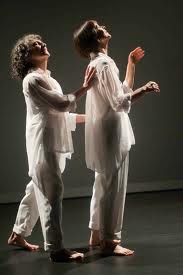
Sara Rudner and Dana Reitz in “Necessary Weather,” with lighting by Jennifer Tipton, photo: Stephanie Berger
In April, Sara Rudner and Dana Reitz glimmered in “Necessary Weather,” a subtle tour de force filled with small moments of great and profound drama and even, unexpectedly, a smile or two. The glide of a foot, cock of a head, even a raised eyebrow or tip of a hat from Rudner and Reitz resonated beneath the glow of Jennifer Tipton’s lighting, which in American Dance Institute’s Rockville studio theater, performed a choreography of its own glowing, fading, saturating and shimmering.
Also at ADI in May, Tzveta Kassabova created a rarified world – of the daily-ness of life and the outdoors. By bringing nature inside and onto the stage, which was strewn with leaves, decorated with lawn furniture, and, in a coup de theatre, a mud puddle and a rain storm. Her evening-length and richly rendered Left of Green, Fall, choreographed on a wide-ranging cast of 16 child and adult dancers and movers, featured sound design and original music with a folk-ish tinge by Steve Wanna. The work tugs at the outer corners of thought with its intermingling of hyper-real and imagined worlds. The senses also come into play: the smell of drying leaves, the crackly crunch they make beneath one’s feet and the moist-wet smell of fall is startling, particularly occurring indoors on a sunny May afternoon. Kassabova, with her flounce of bouncy curls and angular, sharp-cornered body, dances with a laser-like intensity. She’s ready to play, allowing the sounds and sights of children in a park, sometimes among themselves, other times with adults. She’s also game to show off awkwardness: turned in feet, sharp corners of elbows, hunched shoulders and flat-footed balances – providing refreshing lessons that beauty is indeed present in the most ordinary and the most natural ways the body moves.
The Paris Opera Ballet’s July stop at the Kennedy Center Opera House brought an impeccable rendering of one of the pinnacles of Romantic ballet: Giselle. And should one expect anything less than perfection when the program credits list the number of performances of this ballet by the company? On July 5, 2012, I saw the “760th performance by the Paris Opera Ballet and the 206th performance of this production,” one with choreography by Jean Coralli and Jules Perrot dating from 1841, transmitted by Marius Petipa in 1887 and adapted by Patrice Bart and Eugene Polyakov in 1991. Two days later it was 763. The POB still uses the 1924 set and costume designs of the great Alexandre Benois, adding further authenticity to the work. But nothing about this production is museum material. POB continues to breathe life into its Giselle.
Aside from making a pilgrimage to the imaginary graveside of the tragic maiden dancer two-timed by her admirer, it’s hard to find a more accurate and handsome production of this ballet masterpiece. Aurelie Dupont was a thoughtful and sophisticated Giselle, care and technical virtuosity evident in her performance, while her Albrecht, Mathieu Ganio, played his Romantic hero for grandeur. While the 40-something husband and wife duo of Nicholas Le Riche and Clairemarie Osta on paper make an unlikely Albrecht and Giselle, in reality their heartfelt performances were so intensely and genuinely realized at the Saturday matinee that they felt as youthful as Giselles and Albrechts a generation younger.
The production is as close to perfection on so many levels that one might ever find in a ballet, starting with a corps de ballet that danced singularly, breathing as one unit, most particularly in the act II graveside scene. The mime passages, too, were truly beautiful, works of expressive artistry many that in most companies, particularly the American ones, are dropped or given short shrift. Here the tradition remains that mime is integral to the choreography, not an afterthought but a moment of import. Most interesting was a (new to me) mime sequence by Giselle’s mother about the origins of her daughter’s affliction and how she will most definitely die (hands in fists, crossed at the wrists, held low at the chest). Later when the Wilis dance in act II, it becomes abundantly clear why their arms are crossed, though delicately, their hands relaxed: they’re the walking dead, zombies, if you will, of another era. Another unforgettable moment in POBs Giselle, is its use of tableaux at then ending moment of each act. Each act ends in a moment of frozen stillness – act one of course with Giselle’s death, act two with the resurrection of Albrecht. Each of these is captured in a stage picture, then the curtain dropped and rose again – and there the dancers stood, still posed in character. Stunning and memorable.
Each year in August the Karmiel Dance Festival swallows up the small northern Israeli city of Karmiel as upwards of reportedly 250,000 folk and professional dancers swarm the city for three days and nights of dance. From large-scale performances in an outdoor amphitheater to professional and semi-professional and student companies performing in the municipal auditorium and in local gymnasiums and schools to folk dance sessions on the city’s six tennis courts, Karmiel is awash in dance. I caught companies ranging from the silky beauty of Guangdong Modern Dance Company from China’s Guangzhou province, France’s Ballet de Opera Metz under the direction of Patrick Salliot, the youthful and vivacious CIA Brasileira De Ballet, where artistic director Jorge Texeira seeks out his youthful dance protégés from the streets and barrios of some of the poorest neighborhoods in Rio de Janeiro, Terrence Orr’s Pittsburgh Ballet Theater, and Israel’s Kibbutz Contemporary Dance Company, directed by Rami Be’er in a program of new works by young dancemakers. Maybe not the best that I saw, but the unforgettable oddity of the three-day festival was the headlining company, billed as the Cossack National Dance Troupe from Russia. In the grand folk dance tradition of the great Moiseyev company of Russia, these dancers, musicians and singers – numbering 60 strong – let the sparks fly, literally. With breathtaking sword play where white hot sparks truly did fly from the swords, to astounding acrobatic feats and graceful, feminine dances featuring smoothness, precision and delicate footwork parsed out in heeled character boots, the troupe was a hit. Few in the appreciative Israeli crowd – many of whom sang along to the old Russian folk songs buying into a mythic pastoral vision of the Cossack warriors – seemed aware of the irony of an audience of predominantly Israeli Jews heartily applauding a show titled “The Cossacks Are Coming!” The last time Jews were heard to say “The Cossacks are coming,” things didn’t turn out so well.
In September, Dance Place was fortunate to book one of the State Department’s CenterStage touring troupes at the top of its season. Nan Jombang, a one-of-a-kind family of dancers from the Indonesian island of Sumatra, provided a remarkable and moving evening in its North American premiere. Rantau Berbisik or “Whisperings of Exile” begins with a siren call, a female shriek that’s an alarm and cry of pain, that begins a journey of unexpected images. Ery Mefri, a dancer from Padang, on the western coast of Sumatra, has created a surprisingly original dance culture drawing from traditional tribal rituals, martial arts – randai and pencak silak – captivating chants and unusual body percussion techniques. But most unique about Mefri’s artistic project, and the company he founded in 1983, is that it is truly a family affair: the five dancers are his wife and children. The live, sleep, eat and work together daily in intense isolation crafting dances of elemental power and uncommon dynamism through an intensely intimate process.
The work features a trio of gloriously powerful women who exhibit strength of body and will in the earthbound manner they dive into movement, oozing into deep plie like squats and then pounding the taut canvas of their stretched red pants like drummers. Moments later they spring forth from deep lunges, pouncing then retreating, only to strike out again. The hour-long work is filled with mystery and mundanity: dancers carry plates and cups back and forth from a tea cart, rattling the china in percussive polyrhythms, and one woman sits in a chair and keens, rocking and hugging herself for an inconsolable loss. Later the women pass and stack plates around a wooden table with an urgency and assembly-line precision that brings new meaning to the term woman’s work. The one thin boy/man in the group attacks and retreats with preternatural grace, sometimes part of this female-dominated social structure, other times apart – an outcast or loner. And throughout amid the bustle, the urgent calls, the unmitigated pain and sense of loss, there remains a stunning impression of yearning, of hope. The ancient rituals of home and hearth, of work and rest, of group and individual it seems are drawn from a language and way of life that Mefri sees disappearing. Quickly evident in this riveting evening is how Mefri and his family can communicate so deeply to the heart and soul in ways that strike at the core, of unspoken truths about family, community and cultural continuity and conveyance.
One final note of continuity and cultural conveyance was struck resoundingly in December with Chicago Human Rhythm Project’s “Juba: Masters of Tap and Percussive Dance” at the Kennedy Center’s Eisenhower Theater. While the program was long on youth and short on masters – an indication that we’ve reached the end our last generation of true tap masters — Dianne “Lady Di” Walker represented the early tap revival providing the link to old time rhythm tap of the early and mid-20th century. The program, emceed and curated by Lane Alexander of CHRP, brought together a bevy of youthful dance companies, among them Michelle Dorrance’s Dorrance Dance with an interesting excerpt for two barefoot modern dancers and a tapper. D.C. favorite Step Afrika! brought down the first act curtain with its heart-raising rhythms and body slapping percussion. And, closing out the evening, Walker served up “Softly As the Morning Sunrise,” a number as smooth and bubbly as glass of Cristal, her footwork as fast as hummingbird wings, her physics-defying feet emitting more sounds than the eye could see. This full evening of tap also included Derik Grant, Sam Weber, and younger pros Jason Janas, Chris Broughton, Connor Kelley, Jumaane Taylor, Joseph Monroe Webb and Kyle Wildner. The evening with its teen and college aged dancers sounded a note that tap will continue to be a force to reckon with in the 21st century. That it occurred on a main stage at the Kennedy Center was – still – a rarity. Let’s hope the success of this evening will lead to more forays into vernacular and percussive dance forms at the nation’s performing arts center. The clusters of tap fans young and old gathered in the lobby after the show couldn’t bear to leave. If they had thrown down a wooden tap floor on the red carpeting, no doubt folks would have stayed for another hour of tap challenges right there in the lobby.
***
And I can’t forget a final, very personal experience. During the annual Kennedy Center run of the Alvin Ailey American Dance Theater in February, I found myself pulled from my aisle seat to join the dancers onstage in Ohad Naharin’s “Minus 16,” which the company had just added to its repertory in late 2011. Clad in slim fitting business suits and stark white shirts, the dancers make their way to the lip of the stage and stare. The next thing you know, they’re stalking the aisles, climbing over seats, crawling across laps to bring up randomly selected members of the audience. The sequence is fascinating – a mix of the mundane, the ridiculous and the dancerly – inviting in the human element as these god-like dancers canoodle, slow dance, cha-cha and indulge their new-found partners. Soon they corral the group, circle, and in ones and twos the dancers begin to lead the participants off stage, leaving just one – most frequently a woman – standing in the embrace of her partner as the others hug themselves in a smug slow dance. On cue the dancers fall. The woman remains alone, in the spotlight. Frequently aghast, embarrassed, she slinks away.
Dreamlike is the best way I can describe the experience. Audience members seem to be selected according to a particular color, most frequently red judging from the previous times I’ve seen the work. As a “winter” on the color chart, I, of course, frequently wear red from my beret to my purse to a closet full of sweaters and blouses. When the dancers lined up, I felt one made eye contact with me right away. I didn’t avert my gaze and I thought that I could be chosen. But as they came into the audience, he passed me by and I exhaled slightly, relieved not to be selected. The stage re-filled with dancers and their unwitting partners as I watched. Suddenly, the same dancer who caught my eye was at my side beckoning, pulling me from my seat. My hand in his I followed him down the dark aisle and up the stairs. There the music changed frequently from kitschy ‘60s pop to rumba, cha cha, and tango – all recognizably familiar, a Naharin trait. Yet the choreographer definitely wants to keep the novices off guard, which is disconcerting because there are moments when the dancers are completely with you and you feel comfortably in their care, then they leave you to your own devices and all bets are off.
I realized quickly that I had to focus fully on my partner and not get distracted by what others on stage or in the audience were doing. We maintained eye contact throughout and went through a bevy of pop-ish dances: I recall bouncing, lunging, throwing in a bump or two and a great tango – wow, what a lead. Then they mixed things up, pushing all the civilians into a circle then a clump before reshuffling things. Somehow I came out with a new partner and things really heated up as I followed him and he me. I felt my old contact skills tingling back to life as I tried to give as good as he gave. He dipped me and I suspect that when he felt I gave in to it, he realized he could take me further. I don’t know how, but I found myself lifted above his head in what felt like a press. As he turned, I thought I might as well take advantage of this. I’m never going to be in the arms of an Ailey dancer again. I put one leg in passe, straightened the other, threw my head back and lifted my sternum, while keeping one hand on my head so my beret wouldn’t fly. He likely only made two or three rotations, but in my mind it felt like a carnival carousel: incredible. Back on earth with my feet on solid footing, he tangoed and embraced me. I knew what was coming. The slow dance when they lead partners off stage. I realized I might was well give in to the moment, I melted into his embrace and we swayed. Two bodies as one. Eyes closed. I momentarily opened them when I sensed the stage emptying. The only words spoken between us are when I said, “uh oh.” He squeezed me and then dropped to the floor in an X with the remaining Ailey dancers. There I was. Alone. Center stage in the Kennedy Center Opera House. I have been seeing performances there since I was a child in 1970s. I had seconds to decide what I was going to do. “%^&#) it,” I said to myself. “I’m standing here in the Opera House with 2,500 people looking at me. I’m going to take my bow.” I moved my leg into B+, opened my arms with a flourish, dropped my head and shoulders and rose, relishing the moment for all it was worth. Seconds later, the audience roared. I was stunned. I made my way gingerly off stage, still blinded by the spotlights as I fumbled up the aisle to find my seat.
Dreamlike. Throughout I knew this was something I would want to relish and remember and tried to find markers for while maintaining the presence of the moment. I was able to find out who the dancers were (yes, there were two) who partnered me. But I believe that Naharin wants the mystery to remain both for the onlookers and the participants. At intermission people were asking if I was a “plant,” insisting that I must have known what to do in advance. But, no, Naharin wants that indeterminacy, that edginess, that moment of frisson, when the audience realizes that with folks just like them on stage, all bets are off on what could happen. While we often attend dance performances to see heightened, better, more beautiful and more physically fit and skilled versions of ourselves (one of the reasons, I think, that we also watch football, basketball and the like), there’s something about seeing someone just like you or me up on stage. If the middle aged mom who needs to get the kids off to school then go to work the next morning can have such a rarified experience then maybe, just maybe, the rest of us can rediscover something fresh, untried, daring, out of sorts, amid the banality of our everyday lives. In this brief segment – and I couldn’t tell you how long it lasted, but I’m sure not more than five minutes at most – Naharin, through the heightened skill and beauty of professional dancers, offers escape from the ordinary. Audiences live through it vicariously by seeing one of their own up there on stage. For me the experience was unforgetable.
© 2012 Lisa Traiger
Published December 30, 2012
Serious Play
Batsheva Dance Company
“Hora”
Brooklyn Academy of Music
New York, NY
Friday, March 9, 2012
By Lisa Traiger
Ohad Naharin takes playfulness seriously. The white-hot Israeli choreographer and artistic director of Tel Aviv’s Batsheva Dance Company creates dances that are like complex games with no winners or losers. Instead Naharin unleashes his dancers onto his playground, where they bound around like playing pieces in a board game, following his ingrained and rigorous instruction manual. Indeed, through the intelligent beauty of his self-invented movement language, Gaga, his artist’s eye tricks us into seeing his dancers as individuals. For adept movers, Gaga synthesizes the purely physical world into a realm of metaphorical poetry, heightened by movement, which allows dancers tremendous freedom to project to audiences their sensory experiences.
“Hora,” the 2009 work Batsheva brought on its current North American tour captures these idiosyncratic elements in its brash hour for its U.S. debut at the Brooklyn Academy of Music. The audience was captivated by its studied sense of gamesmanship and dancing fully imbued with preternatural alertness.
Structured like a series of vignettes or episodes, “Hora” unspools in a spare environment: a vivid chartreuse half wall boxes the 11 dancers in on both sides and the back of the stage – or playing area – like a Joseph Cornell box assemblage in which the dancers become the found objects in a collected collage. Across the back wall a bare wooden bench invites the dancers to rest and observe when they are not part of the action on stage. This structure recalls – for me at least — Merce Cunningham’s “Squaregame” in the way dancers – players? – remain on stage for the entire piece, sometimes dancing, sometimes seated at the edges of the stage observing, but never removed from the work entirely. Also like Cunningham, Naharin eschews a narrative arc, instead offering up sequences that build to a series of climaxes and then subside into denouements, as the dancers smolder and peter out over and over during the course of 60 minutes.
To accompany the dancers in their advances and recapitulations, Naharin selected pioneering Japanese electronic composer Isao Tomita, known for his synthesized arrangements of best-known Western classics. From the bombastic Wagner overture to “Die Walkure,” to John Williams’s equally over-the-top “Star Wars” theme, to Debussy’s sensual “Afternoon of a Faun,” Tomita’s music sounds oddly spacey and unexpected. By the way, was that whistling tune the theme from the old “Colombo” detective show?
Music isn’t a supportive floor in Naharin’s hands, it’s a tool to propel the dancers into anomalous, quirky riffs and physical phrases that seem drawn from an imaginative and uninhibited world where any and all movement is equally valued. No steps or positions are glorified, or vilified. A monkey-like squat projects as much beauty as a finely stretched leg. A swayed back and jutting chin is no more offensive than a prettily parsed out pas de bourree. So dancers turn in, turn out, twist, wriggle, tremble, squat, scoot, flex, point and teeter on the very tips of their toes. Moments of silence and stillness feel heavily freighted in this world where a languid dancer stretching into arabesque vies with a silly slap battle between a pair of men. After a sequence on the floor where dancers spin and balance seesaw-like on their bottoms, the group in succession rises to an exaggerated runner’s lunge, one knee cocked, the other straight – like an ancient heroic bronze of a bowed discus thrower. These eye catching moments with their unruly vocabulary tickle the edges of memory to place a sound, a phrase of music, a pose or a moving sequence before it disappears again back into the ether.
“Hora” challenges as it is satisfies with its ever-evolving choreographic palette. The dancers begin sitting, their backs against that glowing green wall, before walking forward en masse to confront the audience at the edge of the stage – a favored moment in Naharin’s body of choreography – staring us down with piercing eyes and hardened faces. They turn and dole out a sequence in silhouette, chic in their trim black dancewear – some in dresses, others, shorts. We study their bodies outlilned in high relief, each distinct against the glowing green scrim. One dancer’s chin juts forward, another’s back sways, while a third drops back in the shoulders. This is no corps de ballet unit dancing as one.
These dancers imbue the idiosyncratic choreography with myriad meanings that we outsiders can only guess at. Watching their hyper-intuitive control becomes easily mesmerizes. At times they’re hard-edged, tough, even prickly, like the native Israeli fruit of an indigenous cactus, the sabra. But sabras, like Israelis, the old saying goes, are prickly on the outside, sweet under the skin. That’s the gift Naharin gives the dance world, how to dance below the skin’s surface and still project an aura, a life force, in the process. These dancers have acquired, it seems, some secret wordless access to textures and senses that feels superhuman. Taking it in, you can smell what they smell, taste what they taste, breathe in the same breaths they take. It’s a kinesthesia for all five senses, not just the body.
And yet, “Hora,” for those uninitiated into the sometimes arcane and quixotic worlds Naharin creates, contains nothing expectantly like a hora, the communal circular folk dance with its weaving grapevine steps and held hands. In fact, Batsheva dancers have gone on record as saying that the work’s title is not meant to suggest the popular European Jewish folk dance and that the word has other meanings in other languages, including “hour” in Spanish. Instead, the choreographer eschews circles, a structure he’s favored in some of his other works, including the popular “Minus 16,” and returns to another form he likes: the full line of dancers across the stage moving in unison to confront the audience. It’s an in-your-face way to get the audience on your side, and these dancers have no qualms about possessing a straightforward staredown for as long as it takes. The reality, though, is that when a major Israeli dance company with Batsheva;s renown tours a work called “Hora,” it unquestionably carries a freighted meaning. Denying in the name that root connection simply feels disingenuous.
© 2012 by Lisa Traiger
Published March 14, 2012

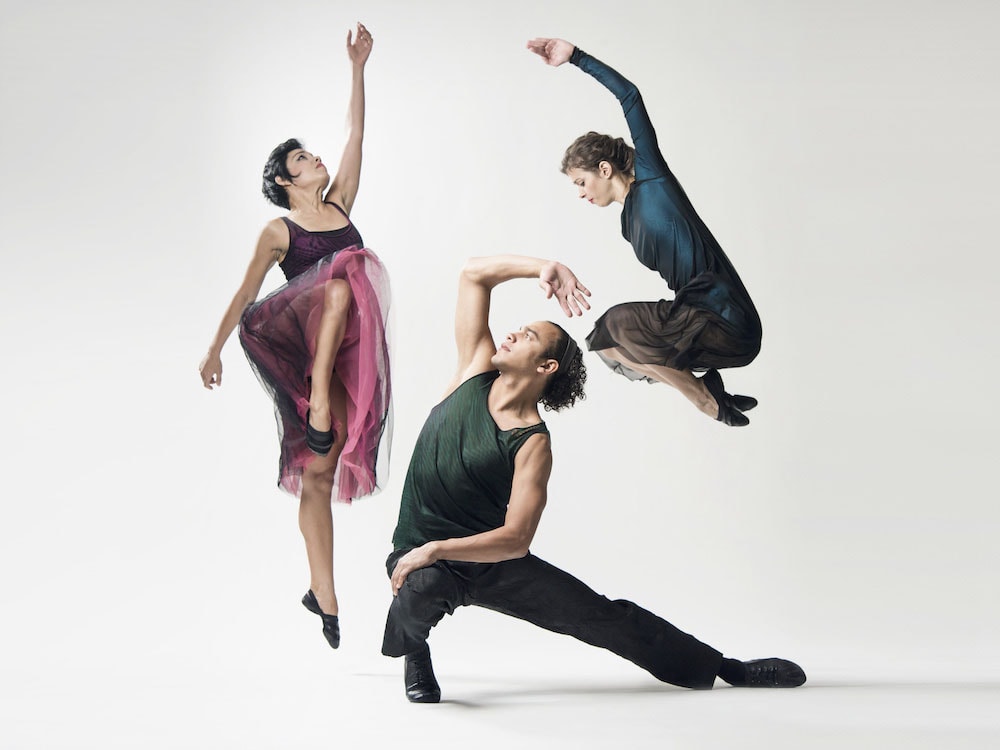

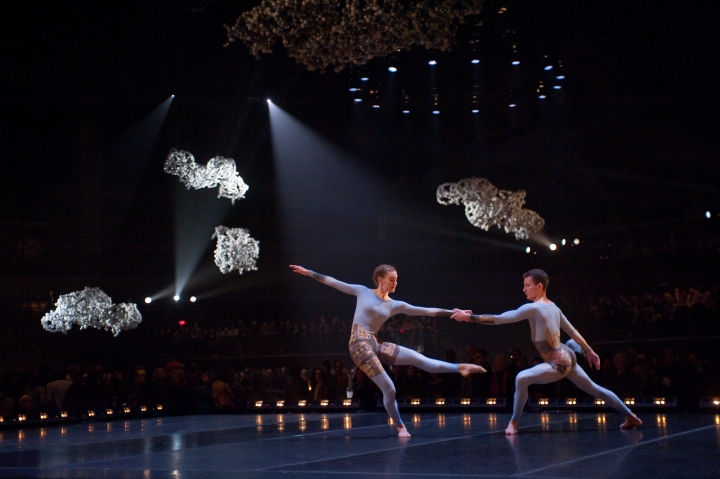
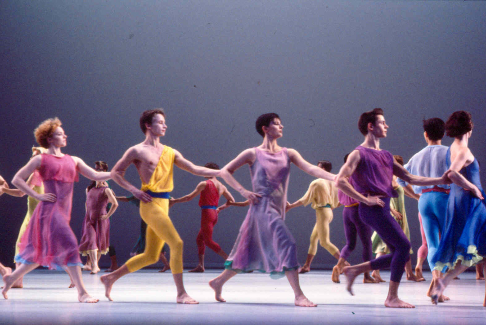
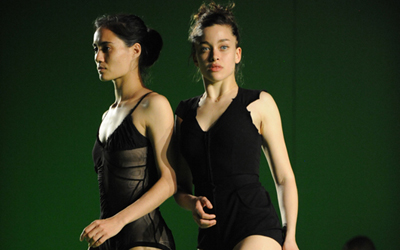
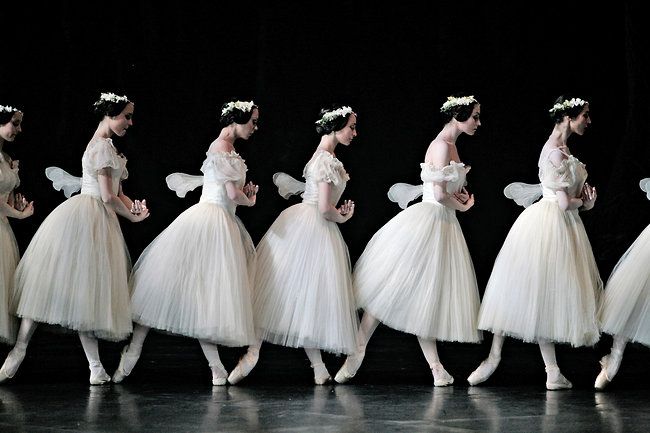

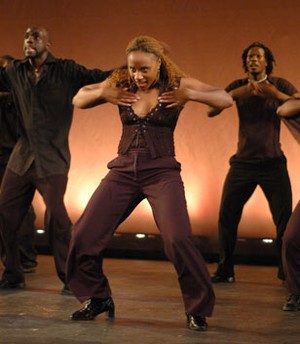
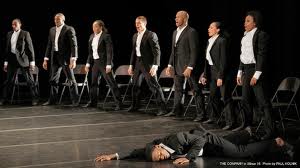


leave a comment